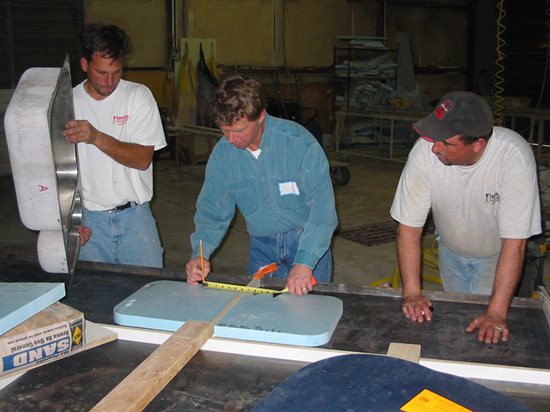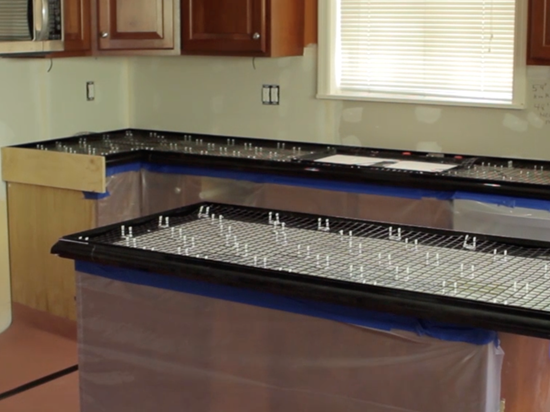
Buddy Rhodes, an expert countertop maker, teaches others the process of making a precast countertop. Buddy Rhodes Concrete Products.
Home remodeling shows make concrete countertops look easy and fun. But for most homeowners they are a very challenging project. In addition to taking multiple days and being physically demanding, here are seven reasons you may want to rethink taking on this DIY project.
Achieving a high-end look takes skill
When creating concrete countertops, it’s tough to get professional results. It’s one thing to try your hand at pouring a simple countertop for your garage or back patio, but when it comes to your kitchen, you want your counters to be a showpiece. Many of the effects you’ve seen in images online—like large seamless islands, waterfall edges, daring cantilevers, or smoothly polished finishes—are difficult to achieve. A professional concrete artisan has already done the trial and error and knows how to achieve the desired results. They can create kitchen countertops that rival the beauty of granite and marble and last for decades.
If you're looking for an easier option, consider countertop resurfacing, where you apply an overlay right on top of your existing counters.You’ll need special tools and materials
The list of tools and materials required to make your own concrete countertop is quite long. Think you’ve got most of what you need on hand? Think again! From melamine boards to a paddle mixer attachment for your drill, see the list of everything you’ll need in this detailed DIY concrete countertop guide.A lot can go wrong
There are many steps involved in making your own concrete countertop. You’ll need to build a mold, make cutouts for appliances and the sink, add reinforcement, monitor the curing process, remove the countertop from the mold, sand or polish the surface, seal the concrete and install the countertop. If you run into a problem at any point in this process all your hard work could be wasted. Even if you consider yourself to be an advanced DIYer, this is a challenging project.The mix has to be just right
It can’t be too wet or too dry. Mix consistency is important because it will impact the difficulty of the project, as well as the final strength and appearance of your countertop. A countertop mix with too much water won’t cure well, leading to weakness and possible cracks or flaking. A mix that is too dry can end up with air bubbles that leave unsightly pinholes in the finished product. In many cases, the instructions on your mix should be adjusted based on your specific circumstances.It is a very messy project
Whether you plan to cast your countertops in place atop your cabinets or precast them in your garage or workshop, be ready for a mess. For cast-in-place counters, you’ll need to be meticulous about protecting your cabinetry and flooring. Even with plastic sheeting and drop cloths, you’ll still run the risk of damaging the existing surfaces in your kitchen. Precasting in a designated work area is a safer bet, but can still be a huge undertaking when it comes to clean up.You won’t immediately know if you’re happy with the results
Since it will take a few days for your countertop to cure, you won’t know if you’re happy with the results until you remove it from the mold. This is the point where many people going the DIY route face disappointment. The color isn’t right, the surface is rougher than expected, or you’ve got pinholes or cracks. Some imperfections can be fixed with slurry or polishing, but now you’ve got an added step.If it isn’t sealed properly, you’ll have problems
One of the most common issues with DIY concrete countertops is the sealer. If you don’t apply it properly it will be less effective, leaving your countertop vulnerable to stains. Common mistakes are applying the sealer at the wrong thickness, not allowing sufficient cure time before sealing, or using the wrong type of sealer. Many homeowners who’ve attempted making their own counters find that they are unhappy with the sealer and have to strip it and try again.

The piece of blue foam is a cutout that will leave an open space for the sink. Concrete Countertop Institute.

When casting in place, protecting the cabinets and flooring is essential. Concrete Countertop Solutions.
Still considering making your own countertop?
If you’re still not sure if you should make a concrete countertop yourself, check out the following real-world examples. Consider their successes and failures before starting your own project, and think about which of these three methods you’d feel most confident with.
Real-world examples of DIY concrete countertops:
- DIY Concrete Countertops (Pour in Place)
From Cara of The Inspired Workshop - DIY Concrete Countertop Tutorial (Precast)
From Wendi of H20 Bungalow - Concrete Countertop DIY (Feather Finish Over Formica)
From Elsie + Emma of A Beautiful Mess
Each of these DIY countertops came out nicely, but there were quite a few bumps along the way. You have to be willing to adapt as you go when taking on a project like this. It is rare that everything goes according to plan.
If you have your heart set on doing concrete countertops yourself, make sure you are prepared and understand the process in advance. Check out these instructional videos from Concrete Countertop Solutions showing how to use their patented countertop building system. If you are really serious about learning the process, consider attending a live training where you can get hands-on experience creating countertops out of concrete.